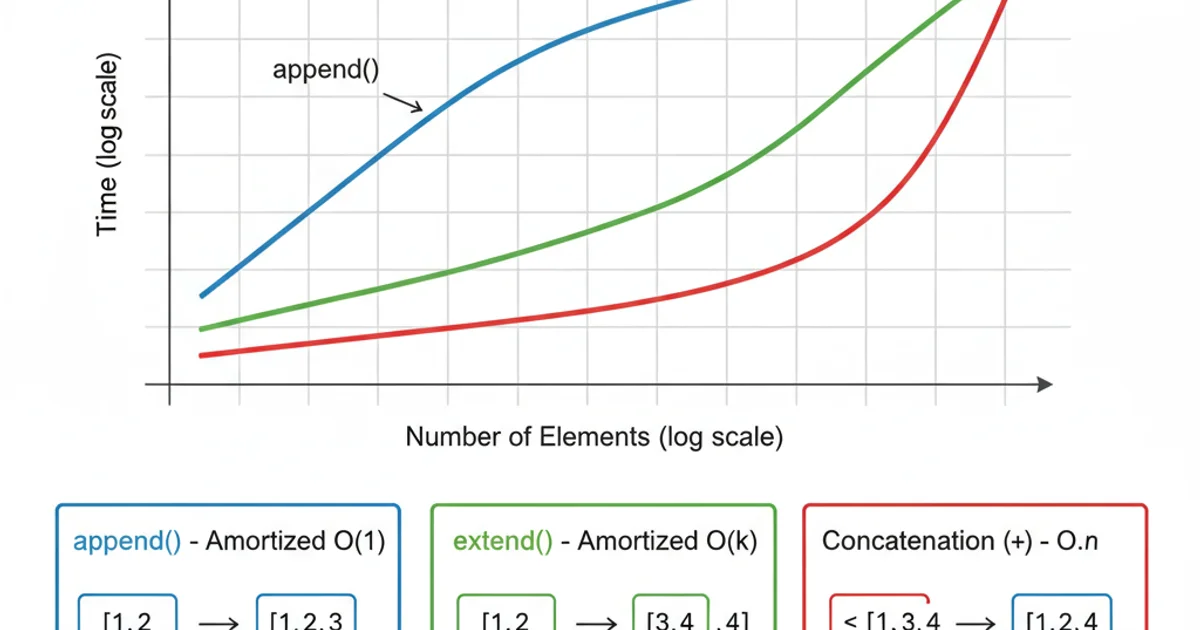Dynamically growing a python array when assigning to it
Categories:
Dynamically Growing Python Arrays: Efficient Appending and Extension

Explore various methods for dynamically adding elements to Python lists (arrays), understanding their performance implications and best use cases.
In Python, the term 'array' often refers to a list, which is a dynamic, ordered, and mutable sequence. Unlike static arrays in some other languages, Python lists are designed to grow and shrink as needed. This article delves into the most common and efficient ways to dynamically add elements to a Python list, along with considerations for performance and readability.
Understanding Python Lists as Dynamic Arrays
Python lists are implemented as dynamic arrays, meaning they don't have a fixed size. When you add elements, Python automatically handles memory reallocation behind the scenes. This flexibility is one of Python's strengths, but understanding how it works can help you write more efficient code. When a list runs out of allocated space, Python typically allocates a larger block of memory (often doubling the current capacity) and copies the existing elements to the new location. This reallocation can be an expensive operation, so choosing the right method for adding elements is crucial for performance-sensitive applications.
flowchart TD
A[Start with empty list] --> B{Add element 'X'}
B --> C{Is there enough space?}
C -- Yes --> D[Append 'X' to current memory]
C -- No --> E[Allocate larger memory block]
E --> F[Copy existing elements to new block]
F --> G[Append 'X' to new block]
D --> H[List updated]
G --> H
H --> I[End]Process of dynamic list growth in Python
Common Methods for Dynamic Growth
Python provides several built-in methods for adding elements to a list. Each has its specific use case and performance characteristics. The most frequently used methods are append(), extend(), and list concatenation using the + operator.
# Using append() for single elements
my_list = []
my_list.append(1)
my_list.append(2)
print(my_list) # Output: [1, 2]
# Using extend() for iterables
my_list.extend([3, 4, 5])
print(my_list) # Output: [1, 2, 3, 4, 5]
# Using + operator for concatenation (creates new list)
new_elements = [6, 7]
my_list = my_list + new_elements
print(my_list) # Output: [1, 2, 3, 4, 5, 6, 7]
Demonstration of append(), extend(), and + operator for list growth.
append() is generally the most efficient. For adding multiple elements from an iterable, extend() is usually preferred over repeated append() calls or list concatenation, as it performs fewer reallocations.Performance Considerations
While all methods achieve dynamic growth, their performance can differ significantly, especially with large lists or frequent operations.
append(): This is an amortized O(1) operation. Most of the time, it's very fast. Occasionally, when reallocation is needed, it becomes O(n) (where n is the current size of the list) due to copying elements. However, because the reallocation strategy typically doubles the capacity, the average cost over many appends remains constant.extend(): Similar toappend(),extend()is also amortized O(k) where k is the number of elements being added. It's more efficient than repeatedly callingappend()for multiple items because it can calculate the required space once and perform a single (or fewer) reallocations.List Concatenation (
+): Using the+operator to combine lists creates a new list. This means both original lists' elements must be copied to the new list, making it an O(n + k) operation (where n is the size of the first list and k is the size of the second). For frequent additions, this can be significantly slower and consume more memory thanappend()orextend().

Conceptual performance comparison for different list growth methods.
+) in a loop to build a large list, as it creates many intermediate lists, leading to poor performance and high memory usage. Prefer append() or extend() instead.Pre-allocating for Performance (When Applicable)
If you know the approximate final size of your list beforehand, you can sometimes pre-allocate space to minimize reallocations. While Python doesn't offer direct pre-allocation like C++ vectors, you can create a list of a certain size and then assign elements to indices. However, this approach is less 'dynamic' and more suitable when you know the exact number of elements and their positions. For truly dynamic growth, append() and extend() are generally sufficient due to their optimized implementations.
# Pre-allocating a list (if size is known)
size = 5
my_list = [None] * size # Initialize with None or a default value
for i in range(size):
my_list[i] = i * 10
print(my_list) # Output: [0, 10, 20, 30, 40]
# This is different from dynamic growth, as elements are assigned, not appended.
Example of pre-allocating a list when the final size is known.